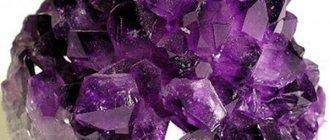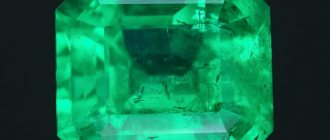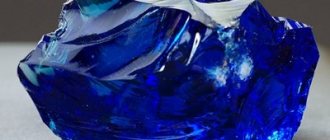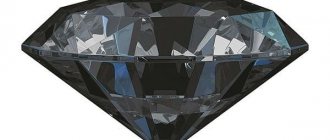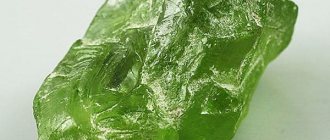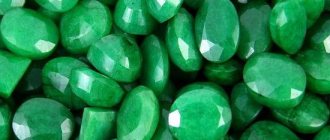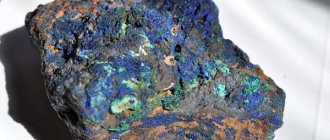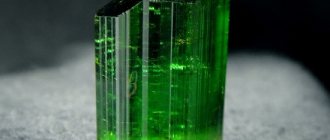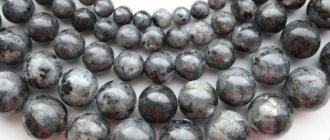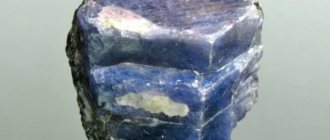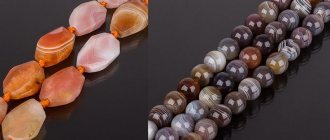- Color: colorless, water-transparent, golden, wine yellow, blue, pink, light green.
- Hardness: 8 points.
- Density: 3.53–3.56 g/cm³.
Topaz has a glassy luster and is often exceptionally clear.
It becomes highly electrified when rubbed. Weak fluorescence is observed in ultraviolet rays. Shades Topaz is often completely colorless or very lightly colored. Yellow shades of varying density are often observed: from pale yellow to thick cherry-brown tones.
There are pure blue topazes and pale green stones mistaken for aquamarines. Red and pink stones are very rare in nature. Beautiful pink topazes, which have long attracted the attention of jewelers, are obtained from Brazilian brownish-yellow stones by heating. This color occurs when heated stones cool and does not appear to fade when exposed to sunlight, as is common with many pink minerals.
This color change is quite easy to reproduce. One avid collector liked to surprise and entertain his guests by placing a crucible of fireproof powder containing a suitable crystal of topaz stone in the fireplace, and after dinner he would remove the pink crystal from the crucible. Heating causes some redistribution of the atoms composing the crystal, since all pink topazes, while maintaining the same crystal shape, have high refractive indices and pronounced dichroism. At the same time, foreign atoms diffuse into the crystal and cause the appearance of different shades of color. By the way, not all yellow topazes turn pink when heated.
Thus, topazes from Ceylon become discolored. Pale colored yellowish-brown crystals from the Urulga River (Russia) fade with prolonged exposure to bright sunlight.
Separately, it is worth mentioning Brazilian topaz: stones of such piercing and bright orange tones cannot be found anywhere else in the world. So the name “Imperial” and its place of honor among the best jewelry stones is justified.
Deposits and production Main deposits: Brazil, Nigeria, Australia, Burma, Mexico, Namibia, Pakistan, Sri Lanka, USA, CIS.
The magnificent topaz crystals come from two vast mining regions in Russia, one stretching along the eastern slope of the Ural Mountains and the other located near Nerchinsk in Transbaikalia.
Beautiful green and blue stones were found near the village of Alabashka east of Nevyansk and in the Ilmen Mountains located to the south, as well as in the gold mines of the Sanarka River, where rare reddish topazes were mined.
Excellent pale brown crystals that fade in sunlight come from the Urulga River on the northern slope of the Borschovochny Range, and good topaz crystals accompany beryls in the Adun-Chelon Range. Both of these locations are located in the Nerchinsk region in Eastern Siberia. Yellow, blue and green topazes were found in the extreme east of Siberia.
Many topazes used in jewelry come from Brazil. Their main deposit is located near Ouro Preto, in the south of the state of Minas Gerais. Crystals of all shades of yellow were found here - from very pale to densely colored wine yellow. Very rarely, red stones were also found here.
In the north-east of the state of Minas Gerais, rolled pebbles of blue and colorless topaz are found, which are present in large quantities in the river pebbles near Arassuaja, here topaz is accompanied by beryl and chrysoberyl.
Processing Topaz does not have a clear commitment to any form of cutting and processing. It can only be noted that translucent varieties are most often cut in cabochon form, and the most popular for faceted stones is the oval cut with 57 facets.
Ennoblement
Topazes are most often refined by irradiation to give them a blue color. Determining the fact of exposure is sometimes quite difficult. The most popular among consumers are light blue (Sky Blue), bright blue (Swiss Blue) and dark blue (London Blue) topazes. However, mined stones rarely have the necessary saturation and brightness of tone, so today almost all natural samples undergo a refining procedure, acquiring a rich blue color. As a result of refining, topazes of the second group of any original shade can be painted in the required blue, and it is possible to subsequently determine whether the stone has been subjected to refining or not only through a complex special study.
Optimal techniques for enhancing the blue color of topaz appeared in 1957. The minerals processed in those years still retain their beautiful color and show no signs of fading.
Story
Why is this stone called topaz?
There are 2 versions about the origin of the name: 1. The gem was named by sailors in honor of the island of Topazios in the Red Sea, near which they were shipwrecked. The historian of Ancient Rome Pliny the Elder wrote that the mineral was mined there. But later it turned out that chrysolites were discovered there. So the second version seems more correct.
2. “Topaz” translated from Sanskrit means “flame, fire, heat.” Most likely, the first gems discovered were golden-orange or red in color.
Since ancient times, topaz has been of considerable importance to humans. Archaeologists have found jewelry and ritual objects made from this stone. During the first excavations in the Ural Mountains, women's jewelry and tools made from this mineral were found. During the Renaissance it was very popular among the nobility. In Rus' he was known as a “heavyweight”.
Place of Birth
There are a lot of deposits of this mineral on our planet. Particularly large ones are in Brazil. This is where the record-breaking stone weighs 5 tons . There are gems of all colors there. Red topazes are highly prized (they are called “Brazilian rubies”).
In Russia, multi-colored stones are mined in Transbaikalia (near Nerchinsk), in the Urals (their figurative name is “Ural diamonds”).
In Germany, colorless samples (called “Saxon diamond”) and wine-yellow samples are found.
Sri Lanka supplies the market with colorless topazes (“water sapphires”) and golden ones.
What to choose for yourself
Before choosing jewelry for yourself, you need to decide what you expect from buying jewelry.
If an item is more expensive, it will emphasize status and belonging to wealthy and business people. Feel free to buy sapphire or sapphire with diamonds, set in gold and platinum.
If you want jewelry for yourself as a result of creative inspiration, it doesn’t matter what stones are diamond, topaz, sapphire or their imitations, the main thing is external beauty.
Perhaps you want to get something worthwhile, but it's expensive. Here, by the way, there will be jewelry where the diamond is replaced with colorless topaz, and the sapphire is replaced with blue topaz. The jeweler will help you select several pieces of jewelry for the set. In addition, even if you have a fairly small amount of money, planning to purchase jewelry with sapphire and topaz, any jeweler and catalog will offer many options.
Every jeweler believes that choosing jewelry based on price is wrong. Jewelry can have a magical and healing effect on its owner, and become an amulet and amulet that affects the whole life.
Description and physical properties
Topaz is a 2nd level semi-precious stone, but due to its beauty, demand and cost, it has been promoted to the precious segment. The composition is aluminum fluorosilicate. The chemical formula is Al2[SiO4](F,OH)2 .
This gem has the following properties:
- Hardness is high - 8 points on the Mohs scale . Despite this, it lends itself perfectly to jewelry processing.
- High density ( 3.49–3.57 g/cm3 ) and transparency.
- Topaz comes in various color shades or colorless. The coloring is usually clear, without haze. There are also “cat’s eye” effects.
- It is easily electrolyzed by friction and temperature changes, which causes a slight tingling sensation on the skin in people.
- Discolors when exposed to sunlight. Can restore color by lying in the dark.
- Heat treatment makes the color rich.
TYPES OF ARTIFICIAL SAPPHIRES
Natural conditions form the mineral over several thousand years. The fake can be received within a few weeks (depending on the size). Counterfeits are similar to the original in physical, chemical, and optical properties, which makes checking a sapphire for authenticity much more difficult.
We recommend: HOW TO DISTINGUISH AMBER FROM A FAKE
The original mineral is imitated in several ways:
- ordinary fake;
- doublet;
- laboratory production;
- analogues among cheaper natural minerals.
Each method has its own methods for identification.
Doublet
Fakes
There are situations when ordinary glass, suitable only for the production of bottles, is passed off as an expensive crystal. This situation is not a disaster, since it is easy to distinguish a fake from a natural sapphire: a bubble structure is observed, and upon tactile contact the fake heats up.
Doublets
Jewelers in professional practice use a large number of composite stones. The structure of sapphire here consists of a number of layers - two (doublet), three (triplet).
The highest craftsmanship - the upper part is made of natural crystal, and the lower part is made of glass, laboratory stone or a cheaper natural substitute. The connection points are easy to detect with a magnifying glass.
Another original way is to hide the problem area under the frame in a fake.
Kyanite
Artificial stones
A common method of producing counterfeits in laboratory conditions is the Verneuil method. The raw material here is natural corundum chips with the addition of chromium, titanium, and iron.
To obtain the desired color, nickel, magnesium, cobalt, and vanadium oxide are used.
The counterfeit is produced by compression and heat treatment (up to 6,000 degrees).
The final product is used in jewelry for technical, medical, and technological purposes. Sapphire glass is used in aviation, rocket science, and luxury watch brands.
It is quite difficult to distinguish hydrothermal sapphire from a natural sample, since they have almost similar characteristics (chemical formula, hardness). In some cases, the fake is even superior to the natural sample.
Other natural gems
Nature is rich in minerals similar to sapphires, but they cost an order of magnitude less:
- kyanite;
- tanzanite;
- tourmaline;
- spinel.
Tanzanite
To identify a stone, a special device is used - a refractometer: it allows you to determine the degree of refraction of light rays. Indicators are rounded to hundredths.
The refractive index for natural sapphire ranges from 1.76 to 1.77.
If we are talking about spinel - 1.72.
A change in the indicator by one hundredth of a part indicates that it is a different mineral.
There are a number of auxiliary signs:
- tanzanite has a red tint;
- blue spinel has a contrasting dark background, it can only be confused with low-grade sapphire;
- Kyanite has a multi-colored banded structure.
Only a jeweler can distinguish tourmaline from sapphire using a special solution.
Spinel
Topazes: types and colors
This stone comes in a wide variety of shades due to its impurities and structure. It sometimes combines several colors at once - such minerals are called polychrome. In nature, yellow varieties of topaz are more common.
Colorless
White or silvery topazes are very common. Since their deposits are located close to the surface of the Earth, sunlight discolors them, turning them transparent.
It is the starting material for obtaining colored topaz.
It is similar to diamonds in terms of clarity, many facets and deep shimmers, therefore it is considered their affordable competitor.
Light blue, blue
These stones are rarely mined. Dark blue colors are often obtained through professional processing.
Minerals of dark blue shades are characterized by increased strength. Blue topaz is considered an example of sophistication and is highly valued by jewelers. The deficiency of natural topaz of a bright blue hue is compensated by the following technology: white minerals are irradiated, resulting in an inky color, which is lightened by heat treatment.
Irradiated specimens are kept under special conditions so that the radiation level becomes safe.
Trade names of blue and dark blue topazes:
- Sky Blue - light, not very expensive.
- Swiss Blue - with a darker shade. The price is higher.
- London Blue - dark blue and dark blue specimens. The darker it is, the higher it is rated. The cutting is done in a special way. London Blue is sometimes mistaken for sapphire.
Yellow
This mineral can have shades ranging from golden to brown. In the most valuable stones, rich yellow turns into blue.
There are many yellow topazes in India, where their medicinal properties were discovered.
Pink, red
These varieties are very expensive.
Red topaz cannot be counterfeited, as there is no technology that can make the crystals turn red while remaining transparent.
Green
This is a rare collectible mineral.
Its natural color, which is not typical for topaz, appears due to exposure to natural radiation.
The crystals have a soft, soft velvety sheen.
Haze and cloudiness indicate artificial processing, which reduces the value.
Black, purple
Deposits are rare. These minerals are difficult to cut. Black stones actually have a deep purple color and a haze inside, which is only noticeable in direct sunlight.
Smoky (rauchtopaz)
This stone is a variety of quartz, mistakenly classified as a member of the topaz family due to its smoky color. The name has become familiar in commerce and everyday life. The color range is from gray to brown.
"Mystic" topaz (rainbow)
Sparkles like a diamond. The crystal lattice creates multicolor. To become rainbow, you need processing, the technology of which was patented at the end of the 20th century. The colorless mineral is irradiated, after which it is coated with a microlayer of titanium or gold.
Imperial (Imperial, Royal)
There is no standard for its coloring. There is yellow, pink, and the orange-brown range is considered the standard. Very prized by jewelers.
Read also : Sapphire - a stone of magical flowering
WHAT IS NATURAL SAPPHIRE DIFFERENT?
- Examine the stone with a magnifying glass. The structure of a natural crystal contains minor defects in the form of colloidal formations (titanium, iron). Stones of British or Latin origin are distinguished by inclusions of peculiar fibers intersecting at an angle of 60 degrees.
- Transparency is of particular importance—as it increases, value increases. However, the absolute transparency of the mineral may indicate that it is a fake.
- Color assessment. Let's say you are dealing with a concentrated blue sapphire. If there are other shades, it is the original, but its cost is much lower than in the case of a single color. Minerals of other colors are also common in nature: pink, yellow, orange, green, black.
- The weight of the stone is calculated in carats (1 carat is a fifth of a gram). A large mineral has a mass of >1 carat, medium 0.99-0.3 carats, small ones 0.01-0.29. Accordingly, the more a mineral weighs, the more expensive it is.
- Natural stone is distinguished by dichroism - it promotes bright shine.
- Processing evaluation. Many edges provide a unique shine and shimmer of the product. Information about the processing class is given on the tag. Products marked with the letter “A” are the highest class of processing, proportionality and symmetry are ideal. Accordingly, with the change of letter, the cut class also changes: “B”, “V”, “G”.
- Tactile contact with the original mineral causes a feeling of cold. A synthetic fake does not give such an effect.
Sapphire
Medicinal properties
Topaz is one of the 12 powerful minerals with strong healing effects.
This is an attribute of the ancient Indian practice of Ayurveda. The healing is enhanced if the jewelry frame is made of silver or yellow gold. Helping on the mental and physical plane, this stone improves a person’s well-being.
In lithotherapy, the healing properties of the following topazes are used:
Colorless
- Increases the body's defenses.
- Helps strengthen the nervous system.
- Improves metabolism, thereby slowing down aging.
- Eliminates hormonal imbalances.
- Useful for insomnia.
- Beads protect against colds.
- Suitable for women's diseases, anemia.
Yellow
- Speeds up metabolism.
- It will help with throat and lung diseases if you wear a necklace.
- Calms nerves, stabilizes excessive emotions, suitable for people who have mental disorders.
- Relieves attacks of bronchial asthma when wearing the pendant.
Blue
- Has a beneficial effect on the thyroid gland if worn around the neck.
- Restores women's health.
- Resists depression.
- Helps with exacerbations of asthma.
- Lowers blood pressure.
Smoky
- It will help make your sleep healing, restful, and without frequent waking up.
- Increases resistance to stress.
- It is not recommended for particularly dreamy people, as it can put them into a trance and immerse them in a different reality.
Pink
- Helps overcome stress.
- Reduces grief.
It is necessary to take into account that these pebbles help increase appetite.
Scientists do not recognize the healing effects of the mineral, but many people prefer to use it as an addition to the treatment recommended by doctors.
Magic properties
Since ancient times, people have been aware of the wonderful magical properties of topaz:
- In the East, it is considered a miraculous gem that promotes enlightenment of feelings and clarity of thoughts, comprehension of wise knowledge.
- Everywhere they believed that this stone was a protector from evil-minded people.
- It is believed that a talisman made from it helps in recognizing intrigue and deception, and in resolving complex cases. The mineral will only help an honest person with pure thoughts.
- Many take it on sea cruises, because they are sure that the crystal can calm the storm.
Who is Topaz suitable for according to their zodiac sign?
According to astrology, it is suitable for all signs except Taurus and Aquarius, for whom it is better to prefer a different talisman.
Agate, malachite, hyacinth, carnelian, emerald are compatible with Taurus, and hawkeye, citrine, aquamarine, and turquoise are compatible with Aquarius. According to the zodiac sign, topaz stone is perfect for Scorpio and Gemini. Its significance for Scorpio is very great. Anyone born under this zodiac constellation has a difficult character. The pebble will smooth out conflicts, help you choose the path to self-improvement, and will be an assistant in matters of the heart.
For different zodiac signs, astrologers recommend stones of a certain color:
- Aries - golden, red, purple, lilac.
- Gemini - white, yellow, golden.
- Cancer - blue, blue, green.
- Leo - yellow, pink, red, purple-violet.
- Virgo - golden, yellow, lilac, purple, greenish, brown.
- Libra - blue.
- Scorpio - everything, but purple and blue shades are preferred.
- Sagittarius - blue.
- Capricorn - brown, greenish, transparent purple.
- Pisces - blue color.
It is better for a person who has many household members not to purchase topaz, even if it suits the horoscope, otherwise discord and chaos are possible in the family.
Topaz is useless for any zodiac sign if a person has dishonest thoughts.
Compatibility with other stones
In order for wearing semi-precious jewelry, talismans and amulets (amulets) to bring only benefits, you should know the energy and properties of these minerals, and take into account their belonging to certain elements.
Topaz is a stone of the Air element, well compatible with its fellow air elements (with the exception of rock crystal) and with Fire stones (except diamond).
This mineral does not combine with stones of Water (aquamarine, opal, pearl, etc.) and Earth (malachite, turquoise, jade, etc.).
How to wear a talisman correctly
In order for topaz to act as a talisman, you must adhere to some recommendations:
- Wear jewelry on the right hand.
- A ring on the index finger will show a person the right path in life.
- The rainbow mineral will work better if it is set in yellow gold.
- Pendants on the chest and bracelets on the right wrist protect against the evil eye.
Some stones lose properties beneficial to humans if they are close to their own kind. With topaz, on the contrary, in this case the strength is multiplied. It coexists peacefully with other minerals of the Air element and even at the same time intensifies many times over.
FORMAL METHODS
Determining the authenticity of a sapphire using methods available to the average person is ambiguous. Of no small importance in how to distinguish natural sapphire from an artificial sample is the help of specialists. The relevant documentation - passport and certificate - must be studied thoroughly, on an individual basis.
Verification of documents
If you don't want to get into trouble, find a jewelry store with a good reputation: such organizations are ready to provide a certificate confirming the authenticity of each precious stone.
The jeweler must provide information regarding the cut of the piece.
Almost every mineral undergoes a number of procedures aimed at refining the stone. During this process, the sapphire is fired or treated with X-rays. Original stones tolerate this treatment quite well, but the synthetic sample acquires a striped structure.
One of the most reliable signs of quality is the cost of sapphire. The original gemstone is expensive.
Invitation of an expert
To eliminate any remaining doubts, when purchasing a product, contact an independent jeweler or gemologist to assess the quality. An expert can provide an initial opinion directly in the store.
To ensure a guaranteed result, you will need to analyze the sapphire using special methods and equipment.
Contacting an expert involves paying for his services, but this amount is insignificant in relation to the cost of the original stone. This will ensure your peace of mind and save your nerves.
Caring for your jewelry
How to properly care for topaz:
- Before cleaning, washing, or cooking, remove rings and bracelets, as household chemicals are destructive to gems.
- Swim in the river, sea, pool and take a shower or bath without decorations.
- Remember that Mystic Topaz spraying is especially vulnerable to reagents.
- Handle the stone with care - one blow can easily split or chip it.
- Any gem loses its shine from contact with cosmetics, so it is better to put on jewelry after your makeup and hairstyle are ready.
- To avoid discoloration, wear them in the evening.
- Wrap the burnt stone in light-proof fabric or put it in a box and close it tightly. After a few days, the rich color will be restored.
- Jewelry should be cleaned regularly: place in a warm soapy solution for about 30 minutes . Then clean with a soft brush and dry.
- If you want to rid the talisman of accumulated bad energy, immerse it for 24 hours . After this procedure, the water must be poured out immediately (don’t forget to just remove the jewelry from it!), then the stone can be worn again.
- The jewelry should be stored in a box that is soft on the inside.
How to care for stone
Ring with blue topaz
Caring for blue topaz is easy. It has good hardness. The stone is stored separately or wrapped in a soft cloth so that it does not scratch its softer precious “neighbors”.
The gem is also very durable. It splits only along cleavage lines. It is difficult to damage a stone, but anything can happen in life - hundreds of strong blows can leave without consequences, and one weak one, but hitting the “Achilles heel”, can split the stone into several parts. Therefore, during special physical activity (sports, etc.), it is advisable to remove jewelry with a sky-blue gem.
Attention!
The main enemy of the beauty of blue topaz is the sun; its direct rays, with prolonged exposure, can discolor the stone. Therefore, it is better to wear it openly in the evening or in cloudy weather.
Blue topaz can become cloudy from contact with aggressive chemicals, so you should only put it on after applying makeup and take it off while using cleaning products or detergents.
How to distinguish from a fake
Topaz is popular and expensive, so it is often counterfeited (most of all, rare varieties of rich tones).
Imitations of these gems are as follows:
- glass;
- cheap stones;
- refined samples.
The origin of topaz can be determined at home:
- Rub the mineral on a woolen cloth. If pieces of paper, hair, or ashes stick to it, then the mineral sample is natural. Some people feel a tingling sensation on the skin when touching a gem.
- Real topaz can scratch quartz and crystal. On the other hand, scratches can only appear from a diamond.
- Stones of natural origin are weakly amenable to heat. Holding them in your hands, you will notice that they remain cold for a long time.
- Once in a solution of methylene iodide, real topaz will instantly sink, and the fake one will float.
- The tones of natural stones are calm and gentle. If they were irradiated, the color will be venomous. A fake can only be accurately identified using special equipment.
- Natural crystals have cracks and defects. A flawless surface indicates imitation.
All of the methods listed will only give a preliminary estimate. They determine the origin of the stone and accurately detect counterfeits in a gemological laboratory.
CHECKING THE ORIGIN OF THE STONE
Let's look at how to determine the authenticity of a sapphire without special equipment and knowledge.
We recommend: Determining the AUTHENTICITY OF TOPAZ
The mineral has certain characteristics that help to uniquely identify it among others.
Mechanical impact
Natural or natural sapphire, unlike synthetic, has sharp corners and flat edges.
The mineral has high hardness and strength; in these parameters it is second only to the hardest stone - diamond.
Either the same crystal or a diamond can leave damage on a mineral.
At the same time, the stone easily leaves marks on hard surfaces: for example, glass.
Try to draw a scratch on a crystal: a natural one will not get any marks, but a fake one will have a crack.
However, this method is not entirely correct; tourmaline can also scratch glass.
Tourmaline
For such a check, it is necessary to select an inconspicuous area on the crystal.
Foreign matter analysis
Since the natural conditions for the formation of the mineral differ significantly from laboratory ones, the origin of sapphire can be determined by visual inspection.
A natural mineral is characterized by the presence of inclusions and heterogeneity of structure. They are visible with a magnifying glass or in bright natural light.
If inclusions are visible without a magnifying glass, it is most likely a low-grade natural sapphire.
The original stone does not have bubbles in its structure. Since fraudsters are familiar with this feature of the stone, they have learned to fake this characteristic, so this method does not provide final confidence in the authenticity of the sapphire.
There is another more reliable way to determine whether a sapphire is real or not.
The product is placed in a jar with monobromonaphthalene solution.
Authentication
The container is placed on a clean, white sheet of paper and illuminated from the side with bright light. This allows you to see inclusions in the form of stripes.
Natural sapphire inclusions have a straight shape, while fake ones have a curved shape.
The asterism effect - a special inclusion in the form of a hexagonal star - is of particular value for jewelers.
It is easy to distinguish the original of such a copy from an analogue: smooth rotation in the case of the original leads to a displacement of the sprocket, while in the case of a fake it will remain in the center. Fraudsters have not yet learned how to effectively fake this effect.
Color
Another reliable way to identify a mineral is the color of the sample. When the lighting changes, the color of a fake also changes, unlike the original.
Sapphire color
The initial assessment is carried out during the day in bright sunlight, then the stone is assessed using bright artificial lighting.
We recommend: Determining a REAL DIAMOND
A change in color in several tones indicates that the sapphire is a fake.
If the crystal has been subjected to heat treatment, this is recorded in the relevant documents. The stone is then evaluated under ultraviolet rays.
A fake sapphire will have a green tint, and the natural mineral will show itself with a light reflection.
Best time to buy
Any day is suitable for purchasing topaz , except 9 and 15 .
You need using it half a month after purchase.
It is better to buy Rauchtopaz on the 9th lunar day, and wear it starting from the 23rd .
During these two weeks, the gem will try to get used to its owner and align with its energy. If this happens, the stone will change its shade to a softer, more pleasant one (for example, yellow to golden).
Price
The cost of topaz is determined by the following criteria:
- color;
- origin;
- cutting;
- weight.
The price is determined by the type of stone. The most expensive minerals are those with red tints, pink, blue and dark blue. The price of such specimens ranges from $300–600 per carat .
Yellow and brown topazes have a lower price - $25–70.
Topaz of garishly poisonous colors can be purchased for - $5–10.
The most expensive are the imperial ones. Their price depends on the color:
- pink, as well as with a predominance of scarlet shades - $500–3500 per carat ;
- yellow - $70–500.
Read also : Scapolite - a stone staff that bestows knowledge
Stone selection criteria
Stone appraisers rely on the following criteria when determining the value of a stone:
- Color. Color saturation directly affects the price of the product. Also, the pebble should be bright and transparent. If the color is somewhat cloudy, then the price of the product may drop significantly.
- Purity. The copy must be clean without inclusions or stains. The purer the stone, the more expensive it is in price.
- Cut. Here the cost of a stone directly depends on the professionalism of the jeweler. One important rule applies here: a high-quality small stone is more expensive than a low-quality large one. That is, the quality of processing is more important than the weight of the product.
- Weight. This indicator directly affects the cost of sapphire or emerald. However, again, do not forget the three previous points: if a 0.5 carat stone has a low class of clarity, color and is poorly processed, then it will be cheaper than a 0.1 carat stone with excellent first three indicators.
